Dear Zazie, Here is today’s Lovers’ Chronicle from Mac Tag dedicated to his muse. Follow us on twitter @cowboycoleridge. Have you lost the fragrance of love’s ways? Have you felt the sting of anguish? Rhett
The Lovers’ Chronicle
Dear Muse,
© copyright 2020 mac tag/cowboy coleridge all rights reserved
survived long discordant days,
despair, and Time’s laggin’ pace
to say farewell to those ways
let the days pass
and drowse those thoughts
a dream long sought
now at hand
no longer gone
grasp the chance
and welcome calm
© copyright 2018 mac tag/cowboy coleridge all rights reserved
on this night, clear
in the moonlight,
a long walk in order,
we arrive at the bridge
deserted at this time
we start across arm in arm
midway we stop to look
over the rail at the river below,
uniformly gray under the nocturnal sky
the water appears to vanish
into an empty space beyond
we turn to each other,
strip our clothes, and disappear
in the depths beneath
a fall with the dizzy
rapidity of a dream
we surface
from the cool water
and cling to each other
in the wan moonlight
we take a deep breath
and descend to the bottom
lost now in the darkness,
in the immensity of life,
in each other
© copyright 2017 mac tag/cowboy Coleridge all rights reserved
Come to me,
come before
it is too late
you alone can draw
the sting of anguish
© copyright 2012 mac tag/cowboy Coleridge all rights reserved

Portrait of Caspar David Friedrich, Gerhard von Kügelgen c. 1810–20
On 21 January 1818, Friedrich married Caroline Bommer, the twenty-five-year-old daughter of a dyer from Dresden. Physiologist and painter Carl Gustav Carus notes in his biographical essays that marriage did not impact significantly on either Friedrich’s life or personality, yet his canvasses from this period, including Chalk Cliffs on Rügen—painted after his honeymoon—display a new sense of levity, while his palette is brighter and less austere.

The chalk drawing Self-portrait, 1800, which portrays the artist at 26, was completed while he was studying at the Royal Academy in Copenhagen. Royal Museum of Fine Arts, Copenhagen




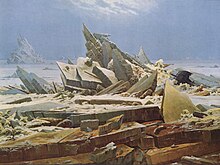
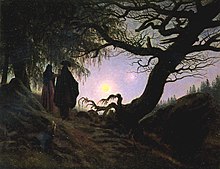

-

Old Heroes’ Graves, (1812), 49.5 x 70.5 cm. Kunsthalle, Hamburg.
-

The Cross Beside The Baltic (1815), 45 × 33.5 cm. Schloss Charlottenburg, Berlin.
-
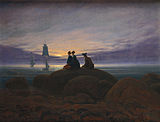
Moonrise Over the Sea (1822). 55 × 71 cm. Alte Nationalgalerie, Berlin.
-

Graveyard under Snow (1826). 31 × 25 cm. Museum der bildenden Künste, Leipzig.
-

The Oak Tree in the Snow (1829). 71 × 48 cm. Alte Nationalgalerie, Berlin.
-

The Stages of Life (Die Lebensstufen (1835). Museum der Bildenden Künste, Leipzig.
-
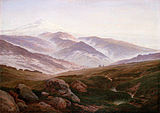
The Giant Mountains (1830–35). 72 × 102 cm. Alte Nationalgalerie, Berlin.
-

Seashore by Moonlight (1835–36). 134 × 169 cm. Kunsthalle, Hamburg.
And on this day in 1840 – Premiere of Giuseppe Verdi’s Un giorno di regno at La Scala of Milan.
Un giorno di regno, ossia il finto Stanislao (A One-Day Reign, or The Pretend Stanislaus, but often translated into English as King for a Day) is an operatic melodramma giocoso in two acts by Giuseppe Verdi to an Italian libretto written in 1818 by Felice Romani. Originally written for the Bohemian composer Adalbert Gyrowetz, the libretto was based on the play Le faux Stanislas written by the Frenchman Alexandre Vincent Pineu-Duval in 1808.
After the success of his first opera, Oberto in 1839, Verdi received a commission from La Scala impresario Merelli to write three more operas. Un giorno was first of the three, but he wrote the piece during a period when first his children and then his wife died and its failure in 1840 caused the young composer to almost abandon opera. It was not until he was enticed to write the music for the existing libretto of what became Nabucco that Verdi restarted his career.
Mac Tag
Isn’t that the way all love affairs run—from dream and cloud-journey to earth-firmness? – Leon Edel


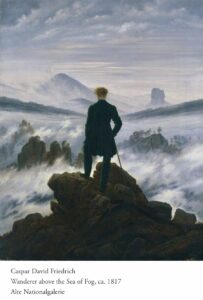


No Comments on "The Lovers’ Chronicle 5 September – immensity – art by Caspar David Friedrich"